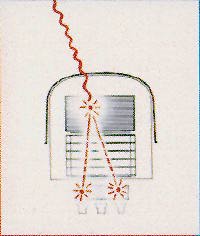
EGRET is the highest energy experiment onboard Compton with sensitivity up to 30 GeV.
The Energetic Gamma-Ray Experiment Telescope (EGRET) is sensitive to photons in the energy range from 20 MeV to 30 GeV, the highest energies accessible by the Compton instruments. Like COMPTEL, EGRET is an imaging instrument. The basic instrument design is that of a spark chamber, technology which is borrowed directly from high-energy physics. The cosmic gamma ray enters the instrument and interacts with absorber material. At these energies, pair production is the dominant process. The gamma ray is converted into an electron/ positron pair. As this pair travels through the gas-filled chamber, sparks are detected in electrified wires which criss-cross the chamber. The spark chamber essentially takes a picture of the trail of the pair as they pass through the instrument. These tracks lead back to the incident direction of the cosmic photon, allowing EGRET to image the sky. Once the pair exits the chamber, they are absorbed by a scintillator which gives a good estimate of the total pair energy, and hence the energy of the incident photon. EGRET is in the tradition of previous spark chamber experiments
which have detected pulsars and active galaxies as high-energy gamma-ray sources. The improved sensitivity of EGRET, however, allows for much more detailed study of such objects. EGRET is also intended to perform detailed studies of diffuse gamma-ray emission. This emission is the result of interactions of cosmic rays with interstellar material, the study of which provides important information about the origin of cosmic rays. There are also many gamma-ray sources detected at EGRET energies which are unidentified at any other energy. No known counterpart exists for these sources and uncovering their identity is another important aspect of EGRET science. Beyond their individual capabilities, the CGRO instruments work together to provide an even more comprehensive study of nature. For instance, BATSE can provide signals to the other three instruments which allow them to respond, with tailor-made instrument configurations, to solar flares or gamma-ray bursts. EGRET, COMPTEL, and OSSE often observe the same object simultaneously, affording tremendous potential for further understanding of detected sources. The CGRO instruments often observe sources simultaneously with other satellite- or ground-based observatories to provide a truly comprehensive view. This approach, called multi-wavelength astronomy, gives scientists the most complete information about our universe. Ultimately, however, the gamma ray view by itself has proven to be pretty spectacular!